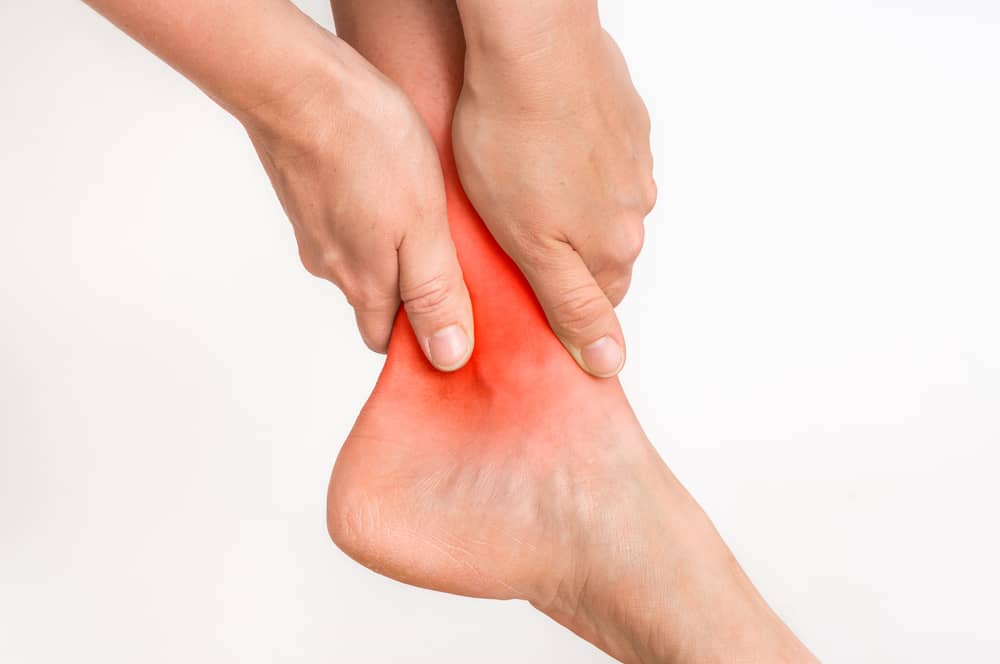
A quick search on the internet for most common ankle sprains will show that roughly 75% of all ankle sprains are what is referred to as “Inversion” ankle sprains. This injury occurs due to excessive rolling of the foot and ankle to the outside of the foot. Inversion is the foot position you would be in if you were to walk on the outside of your foot. Eversion is the opposite foot position and eversion ankle sprains occur less often and will not be apart of this particular blog post; however, this might be a good topic for us to discuss another day.
Almost all ankle sprains are due to an excessive force to the ankle applied in this extreme inverted foot position. Most ankle injuries are sustained due to several factors which may include ballistic sports activities, walking or running on uneven surfaces, prior ankle injuries, improper shoe wear, and poor physical condition. Ballistic sports are characterized as any sport needing quickness, explosive movements, and agility. With these quick explosive movements, the ground reactive forces applied to the foot and ankle are such that the ligaments of the foot and ankle may be overloaded or overstretched causing foot and ankle injury.
If you have ever walked on cobble stone streets in Savannah, Georgia you can testify to the negative effects of walking or running on uneven surfaces. When I think of these type of surfaces, “trail running” comes to mind as well as playing on poor field quality with clumpy lumpy grasses. I can remember playing college soccer on uneven fields, thinking about each grassy clump as a land mine just waiting for some poor soccer player to come along and set it off. It does not take much imagination to consider how uneven surfaces can negatively affect the foot and ankle.

As a Sports Physician, I find myself walking around town watching other peoples gait and thinking to myself how poor their shoe wear is and what a difference good shoe wear would be to help restore the proper biomechanics of walking and running. This is a unique time in the life of footwear as now more than ever it is both at its best and worst. I am constantly assessing patients shoe wear for durability, stability, and motion control. I could write an entire blog just on the necessity for good shoe wear to help maintain proper foot and ankle control while playing sports or walking down the street for that matter. Needless to say, footwear is crazy important when talking about inversion ankle sprains.
To this point, I can’t tell you how many times we have heard a patient say they were walking down the street or in the house and sprained their ankle. Some of this is due to lack of physical condition or what we consider deconditioning due to lack of physical activity. I am thinking of the dad who is a desk jockey and wants to go outside and show his children that “Dad still has skills” and ends up with a grade II inversion ankle sprain. This happens all the time!

Grade I Inversion ankle sprains are described as an overstretch of the affected structures having minimal swelling in and around the outside of the ankle joint as well as mild to moderate pain and tenderness with touching the affected area. There will also be a 25% loss of ankle mobility due to pain and swelling. The foot and ankle in question will not tolerate fast walking and will exhibit pain with single leg toe raises and light single leg hopping.
The course of treatment will be to P.R.I.C.E. (protect, rest, ice, compress, elevate) the ankle for the first 48-72 hours. There must be no pain with walking, or a brace or crutches will be needed in order to accomplish pain free ambulation/waking. You must not walk on the affected foot until there is little to no pain with weightbearing. Mobility is key so after the first 48 hours and within a pain free range one should begin ankle mobility exercises such as using the toes on the affected foot to draw the alphabet in the air. Sometimes we will ask the patients to write their name in cursive with the toes of the affected foot. This promotes increased healing with a full and free range of motion. Once you are able to weight bare pain free you must then start to strengthen the ankle and work on your balance. Balance is the fastest and quickest way to rehab an ankle injury. These exercises should be safe yet challenging to the affected foot and ankle.
Grade II Inversion ankle sprains are described as having multiple ligaments involved with possible partial micro-tearing and moderate to severe pain with single leg toe raises. Swelling will be pitting and full on the affected outside of the foot and may continue to the front and back side of the ankle. The foot and ankle will not be able to tolerate weightbearing nor single leg hopping. Pain will be 4-8/10 on the pain scale and there will be a 50-70% loss of active mobility in the ankle joint. There will also be bruising around the outside of the ankle and foot over the course of the first 72 hours following the injury.
The course of treatment for the first 72 hours will be the same as for a Grade I (P.R.I.C.E). It is imperative that you be able to offload the foot and ankle with crutches or a walking boot until you are able to weight bare without pain. This may take up to 2 weeks and then an additional 7-10 days in a stabilizing ankle brace. With a Grade II ankle sprain it is my professional opinion that seeking the help of a trained sports medicine specialist is appropriate to assess and speed up the healing process with the most effective means possible.
A functional rehabilitative program will be needed for the patient to return to sport in a safe and supported way. The Home Program will start with controlling pain and the inflammatory process, improve pain free range of motion and a range of motion that is freely accessible. The next phase of Home care will be to increase balance work and strength of the affected joint.
Grade III Inversion ankle sprains are described as a complete tear of the ligament in question and or the joint capsule with possible fracture of the fibula or tibia. This is an extreme injury and will need the expertise of a trained physician and possible diagnostic imaging to see the extent of the damage.
It is necessary to seek professional help in these cases and surgery may be required. The key is to P.R.I.C.E for the first 72 hours and maintain good pulses in the arteries of the foot and ankle. Seek treatment within the first 72 hours so that the extent of the injury can be assessed and measured appropriately. Rehab will be necessary at the appropriate time which may very depending on the severity of the joint and ligament damage.
If you think you have a Sprained Ankle, call us to find out. Sprained Ankle treament in knoxville is not far away. We have highly qualified doctors to help you with non surgical and drug-free treatment of your injury. If you have any questions about this please feel free to call us and we will be happy to speak with you in depth.
-Dr. Bert

8029 Ray Mears Blvd, Suite 300
Knoxville, TN
37919
Phone: 865-337-5574
Monday
7am-12pm & 1pm-6pm
Tuesday
7am-12pm & 1pm-4pm
Wednesday
7am-1pm
Thursday
7am-12pm & 1pm-6pm
Friday
7am-12pm & 1pm-4pm
Saturday & Sunday
Closed